Abstract
Shaw, Maxwell K. (University of California, Davis), and John L. Ingraham. Fatty acid composition of Escherichia coli as a possible controlling factor of the minimal growth temperature. J. Bacteriol. 90:141–146. 1965.—If Escherichia coli ML30 is shifted from 37 to 10 C during exponential growth in glucose minimal medium, a 4.5-hr lag results. During this lag, the proportion of unsaturated fatty acids increases in the cellular lipids. However, the adjustment of the fatty acid composition does not appear to be prerequisite to growth at 10 C. If shifts are made to 10 C into minimal medium containing glucose after starvation for glucose at 37 C for 0.5 and 16 hr, the lag periods at 10 C are 4.5 and 6 hr, respectively. Withholding glucose during the lag periods does not affect the duration of the lag periods, but no change in fatty acid composition occurs if glucose is not present. Supplementing the medium with glucose after the lag period permits immediate growth at 10 C; however, the fatty acid composition is still typical of cells grown at 37 C. It is concluded that the fatty acid composition of cells does not determine the minimal temperature of growth.
Full text
PDF





Selected References
These references are in PubMed. This may not be the complete list of references from this article.
- KANESHIRO T., MARR A. G. cis-9,10-Methylene hexadecanoic acid from the phospholipids of Escherichia coli. J Biol Chem. 1961 Oct;236:2615–2619. [PubMed] [Google Scholar]
- KATES M., BAXTER R. M. Lipid composition of mesophilic and psychrophilic yeasts (Candida species) as influenced by environmental temperature. Can J Biochem Physiol. 1962 Sep;40:1213–1227. [PubMed] [Google Scholar]
- MONOD J., COHEN-BAZIRE G., COHN M. Sur la biosynthèse de la beta-galactosidase (lactase) chez Escherichia coli; la spécificité de l'induction. Biochim Biophys Acta. 1951 Nov;7(4):585–599. doi: 10.1016/0006-3002(51)90072-8. [DOI] [PubMed] [Google Scholar]
- Marr A. G., Ingraham J. L. EFFECT OF TEMPERATURE ON THE COMPOSITION OF FATTY ACIDS IN ESCHERICHIA COLI. J Bacteriol. 1962 Dec;84(6):1260–1267. doi: 10.1128/jb.84.6.1260-1267.1962. [DOI] [PMC free article] [PubMed] [Google Scholar]
- NG H., INGRAHAM J. L., MARR A. G. Damage and derepression in Escherichia coli resulting from growth at low temperatures. J Bacteriol. 1962 Aug;84:331–339. doi: 10.1128/jb.84.2.331-339.1962. [DOI] [PMC free article] [PubMed] [Google Scholar]


